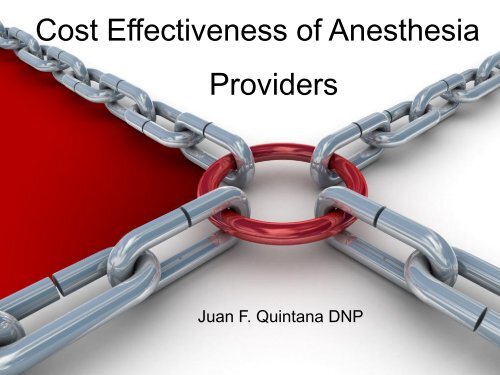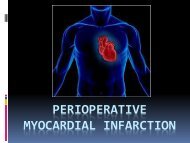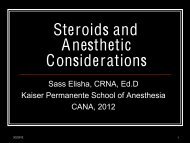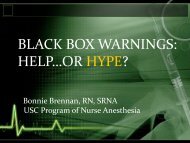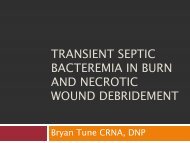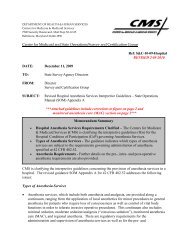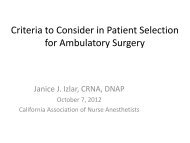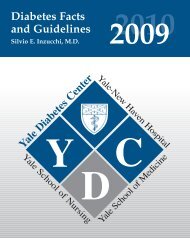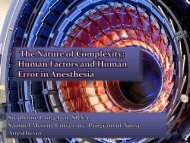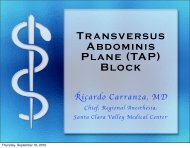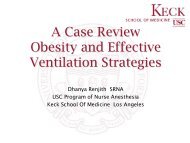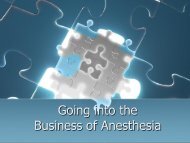Cost Effectiveness and Anesthesia Providers
Cost Effectiveness and Anesthesia Providers
Cost Effectiveness and Anesthesia Providers
You also want an ePaper? Increase the reach of your titles
YUMPU automatically turns print PDFs into web optimized ePapers that Google loves.
<strong>Cost</strong> <strong>Effectiveness</strong> of <strong>Anesthesia</strong><br />
<strong>Providers</strong><br />
Juan F. Quintana DNP
The <strong>Cost</strong> <strong>Effectiveness</strong> of <strong>Anesthesia</strong> Study<br />
conducted by the Lewin Group<br />
has been funded in collaboration with the<br />
AANA <strong>and</strong> AANA Foundation
Outline<br />
• Purpose<br />
• Education<br />
<strong>Cost</strong> <strong>Effectiveness</strong> of Educating CRNAs<br />
• Quality<br />
Claims Information<br />
• <strong>Anesthesia</strong> Practice Models<br />
<strong>Cost</strong> Effective <strong>Anesthesia</strong> Delivery Models<br />
• Access<br />
The Value Added Component
Purpose<br />
• Assess the cost effectiveness of CRNAs<br />
<strong>and</strong> Anesthesiologists with regard to<br />
<strong>Cost</strong> of Education, Quality of Care, <strong>Cost</strong><br />
<strong>Effectiveness</strong> of <strong>Anesthesia</strong> Practice<br />
Models <strong>and</strong> Access to Care.
Education
Educational <strong>Cost</strong> - Literature Review<br />
(all estimates converted to 2008 dollars)<br />
CRNA Education<br />
$52,076 (Direct <strong>Cost</strong>) Gunn (1996)<br />
$287,382 (Social <strong>Cost</strong>) Fagerlund (1998)<br />
MD (PGY 2-4)<br />
$321,000 (Direct <strong>Cost</strong>) Dodoo, Phillips (2008)<br />
$301,178 (Direct <strong>Cost</strong>) Franzini, Berry (1997)<br />
$-114.031 (Direct + productivity) Franzini, Berry (1997)<br />
$245,969 (+ opportunity cost) Franzini, Berry (1997)<br />
modified by Hogan to include opportunity cost<br />
$229,267 (Direct, before GME offset) Pisetsky, Lubarsky, et<br />
al (1998)<br />
$-213,000 (w/ productivity offset + GME subsidy) Pisetsky,<br />
Lubarsky, et al (1998)<br />
$146,940 Pisetsky, et al (1998) w/ productivity offset with<br />
opportunity cost (Hogan)
Educational <strong>Cost</strong>-<br />
Lewin Group<br />
• Three types of cost included:<br />
– Direct education costs<br />
– Opportunity cost of student/resident’s time<br />
– Value of student/resident services while<br />
training
Educational <strong>Cost</strong><br />
Assessment<br />
CRNA<br />
Direct:<br />
Pre-<strong>Anesthesia</strong>: $53,696<br />
<strong>Anesthesia</strong>: $68,465<br />
Opportunity: $291,353<br />
Productivity: - $251,704<br />
Total: $161,809<br />
Anesthesiologist<br />
Direct:<br />
Pre <strong>Anesthesia</strong>: $623,818<br />
<strong>Anesthesia</strong>: $494,420<br />
Opportunity: $897,793<br />
Productivity: - $775,073*<br />
Total: $1,083,795
<strong>Anesthesia</strong> <strong>Providers</strong><br />
Produced<br />
CRNA<br />
670<br />
$$$<br />
MDA<br />
100
Conclusions:<br />
Educational <strong>Cost</strong><br />
• Direct costs <strong>and</strong> Economic cost of educating CRNAs are<br />
significantly lower than the cost of anesthesiologists<br />
– Economic costs of graduate education for CRNA are 1/4th the cost<br />
of anesthesiologists<br />
– Total education costs of CRNAs are about 15% of the cost of<br />
anesthesiologists<br />
• Key cost drivers:<br />
– Faculty cost <strong>and</strong> student-faculty ratio<br />
– Program length<br />
– Student opportunity cost<br />
– Productivity of students in clinical portion of graduate education
Quality
Quality:<br />
Literature<br />
Majority - no statistically significant difference between anesthesiologists <strong>and</strong><br />
CRNAs after controlling for other relevant factors<br />
– Minnesota Department of Health, 1995<br />
– Cromwell, 1999, Posner & Freund, 1999<br />
– Hoffman, Thompson, Burke, & Derkay, 2002<br />
– Pine, Holt, & Lou, 2003; Smith, Kane, & Milne, 2004<br />
– Simonson, Ahern, & Hendryx, 2007<br />
– Needleman & Minnick, 2008<br />
– RTI & Cromwell, 2010<br />
• Exceptions: Silber et al 2000<br />
• <strong>Anesthesia</strong> Complications for Analyses: Donnelly & Buechner, 2001
Quality:<br />
Records Review<br />
Nationwide Inpatient Sample (NIS) 2007 data<br />
N % Weighted N %<br />
No 8,034,162 99.88% 39,496,584 99.89%<br />
Yes 9,253 0.12% 45,364 0.11%<br />
Ingenix National Database<br />
N = 52,636 claims;<br />
No complications<br />
National Survey of<br />
Ambulatory Surgery (NSAS)<br />
N = 52,233*,<br />
Weighted N = 34,738,440
Conclusions:<br />
Quality<br />
• Incidence of complications due to anesthesia, regardless of<br />
delivery model, is low <strong>and</strong> declining<br />
• With some exceptions, literature suggests no statistically<br />
significant difference in complication rates or mortality rates<br />
between CRNA <strong>and</strong> anesthesiologists<br />
• Analysis of claims data is consistent with very low incidence<br />
of complications, <strong>and</strong> no differences between provider type
<strong>Anesthesia</strong><br />
Practice Models
<strong>Cost</strong> <strong>Effectiveness</strong>:<br />
Literature Review<br />
Simulation Analyses<br />
• Abenstein et al (2004), data from Silber et al (2000)<br />
• Medical direction model is more cost effective with respect to QALY’s than a<br />
model in which CRNAs act independently<br />
• Data is NOT based on mortality due to anesthesia (Silber Study)<br />
• Variation in delivery models may be correlated with variation in other factors<br />
affecting quality of care or patient risk.<br />
• Glance (2000)<br />
• Anesthesiologist model not cost-effective<br />
• Direction-models are cost effective, with ratios varying optimally based on<br />
risk class of case.<br />
• Subjective estimates of risk<br />
• Not clear how a given setting could adjust quickly to different models<br />
depending on risk
<strong>Cost</strong> <strong>Effectiveness</strong>:<br />
Literature Review<br />
Simulation Analyses<br />
Quintana (2009) estimated costs associated<br />
with a number of different delivery models<br />
• Quality outcomes are held constant<br />
• Anesthesiologist intensive forms of delivery are<br />
less efficient, <strong>and</strong> more likely to require<br />
subsidization by the hospital
<strong>Anesthesia</strong><br />
Practice Models<br />
<strong>Cost</strong> Effective<br />
12 ORs<br />
High / Low<br />
Dem<strong>and</strong><br />
CRNA<br />
MDA<br />
ACT<br />
Collaborative<br />
(Supervision)<br />
H -<br />
<br />
H -<br />
<br />
H - -<br />
H -<br />
<br />
L -<br />
<br />
L -<br />
<br />
L -<br />
<br />
L - -
<strong>Cost</strong> <strong>Effectiveness</strong><br />
Conclusions:<br />
Simulation Analyses<br />
• CRNAs acting independently is the MOST cost efficient model<br />
<strong>and</strong> MOST attractive financially<br />
• Where dem<strong>and</strong> is high, supervisory model (1:4+) <strong>and</strong> direction model (1:4)<br />
become relatively more attractive financially<br />
–Supervisory (Collaborative) model is the second least costly model<br />
• When dem<strong>and</strong> is constrained, models which require larger dem<strong>and</strong> become<br />
less cost effective<br />
• There are no circumstances examined in which a 1:1 direction model is cost<br />
effective or financially viable<br />
• When dem<strong>and</strong> is highly uncertain, CRNAs acting independently becomes<br />
relatively more attractive financially
Claims Analysis<br />
Average Billed<br />
Delivery Model<br />
Anesthesiologist<br />
only<br />
N<br />
33,24<br />
9<br />
Average<br />
Billed<br />
Amount<br />
$1,087.15<br />
Direction 1:2-4 11,022 $1,434.19<br />
Direction 1:1 2,021 $1,544.36<br />
CRNA only 6,344 $1,059.34
Claims Analysis<br />
Allowed Amounts<br />
Delivery Model N Allowed<br />
Amount<br />
Anesthesiologist<br />
only<br />
33,249 $470.54<br />
Direction 1:2-4 11,022 $438.13<br />
Direction 1:1 2,021 $477.57<br />
CRNA only 6,344 $307.23
Conclusions:<br />
Claims Analysis<br />
<strong>Cost</strong> Effective<br />
Billed Amounts<br />
CRNA < all other models<br />
Lowest to highest cost<br />
– CRNA only<br />
– Anesthesiologist<br />
only<br />
– Direction 1: 2-4<br />
– Direction 1:1<br />
Reimbursed Amount<br />
CRNA < all other models<br />
Lowest to highest cost<br />
–CRNA only<br />
–Direction 1:2-4<br />
–Anesthesiologist only<br />
–Direction 1:1
Claims Analysis<br />
Caveat<br />
Delivery Model N % Cases<br />
Anesthesiologist only 33,249 63%<br />
Direction 1:2-4 11,022 21%<br />
Direction 1:1 2,021 4%<br />
CRNA only 6,344 12%<br />
Total 52,636 100%
Access
Access:<br />
The Value Added Component<br />
CRNAs as the primary anesthesia providers<br />
in the rural United States provide a Value Added<br />
Component.<br />
All things being equal (which they are not) we bring<br />
more to the table
Access to Care: CRNAs per Population<br />
CRNAs Are in Most Counties of the Country
Access to Care: Anesthesiologists per<br />
Population Concentrated in Urban Areas
Percent<br />
Percentage of Urban Counties by<br />
<strong>Anesthesia</strong> Provider Type<br />
80%<br />
70%<br />
71%<br />
60%<br />
50%<br />
40%<br />
30%<br />
No Anesthesiologists/CRNAs<br />
CRNAs Only<br />
Anesthesiologists Only<br />
Anesthesiologists <strong>and</strong> CRNAs<br />
20%<br />
10%<br />
9%<br />
16%<br />
4%<br />
0%<br />
<strong>Anesthesia</strong> Provider Type
Percent<br />
Percentage of Rural Counties by<br />
<strong>Anesthesia</strong> Provider Type<br />
40%<br />
35%<br />
34%<br />
35%<br />
30%<br />
27%<br />
25%<br />
20%<br />
15%<br />
No Anesthesiologists/CRNAs<br />
CRNAs Only<br />
Anesthesiologists Only<br />
Anesthesiologists <strong>and</strong> CRNAs<br />
10%<br />
5%<br />
0%<br />
4%<br />
<strong>Anesthesia</strong> Provider Type
Conclusions:<br />
Access<br />
• CRNAs significantly exp<strong>and</strong> access to<br />
anesthesia services across the county<br />
• Lower cost<br />
• Greater physical access<br />
• Particularly exp<strong>and</strong> care to rural areas<br />
• Value Added Component
Summary<br />
CRNAs are 6x more <strong>Cost</strong> Effective to Educate than<br />
Anesthesiologists<br />
Quality of <strong>Anesthesia</strong> services is better than it ever has been<br />
without significant differences between CRNA <strong>and</strong><br />
Anesthesiologists<br />
Increased CRNA autonomy <strong>and</strong> more precisely<br />
Independence improves the Practice Models:<br />
<strong>Cost</strong> <strong>and</strong> Efficiency<br />
CRNAs provide the Healthcare system the Value Added<br />
Component of increased Access to anesthesia services in<br />
Rural America
<strong>Cost</strong> <strong>Effectiveness</strong><br />
Technical Advisory Panel<br />
• Nancy Bruton-Maree, CRNA, MS<br />
• Larry G. Hornsby, CRNA, BS<br />
• Betty J. Horton, CRNA, PhD<br />
• Kenneth C. Plitt, CRNA, MBA<br />
• Juan F. Quintana, CRNA, DNP<br />
• Paul Santoro, CRNA, MS<br />
• Jim Scarsella, CRNA, MSF<br />
• Bruce A. Schoneboom, CRNA, PhD, FAAN<br />
• James Walker, CRNA, DNP<br />
• Lorraine M. Jordan, CRNA, PhD (Staff)
Juan F. Quintana CRNA, DNP<br />
Sleepy <strong>Anesthesia</strong> Associates PLLC<br />
364 Private Road 8581<br />
Winnsboro, TX 75494<br />
a_sleeper2@yahoo.com<br />
The Lewin Group<br />
3130 Fairview Park Drive<br />
Suite 800<br />
Falls Church, VA 22042<br />
Main: (703) 269-5500<br />
www.lewin.com


